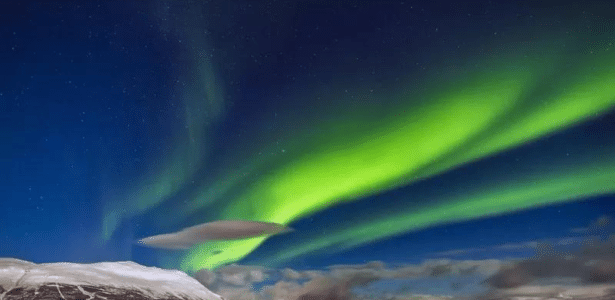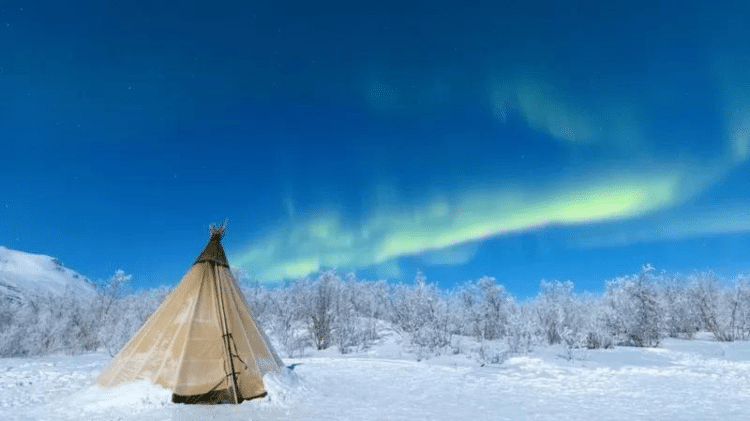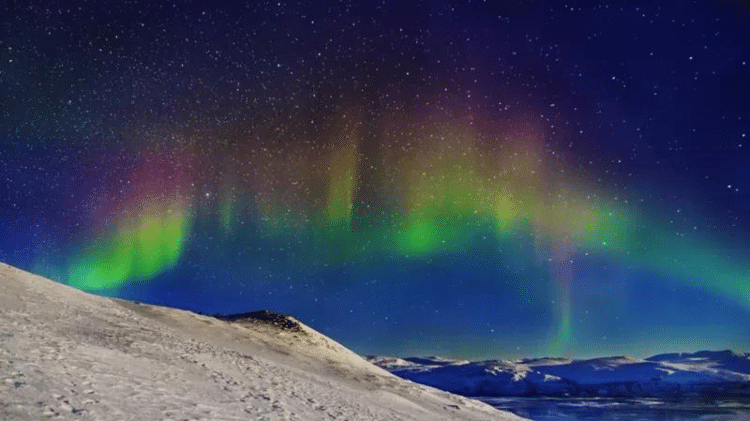“I’m not sure we’ll see the northern lights,” says my video producer friend Erik Jaråker as we watch the fog around us.
I was driving on a one-lane road to Abisko, one of Sweden’s northernmost cities, 250km north of the Arctic Circle. We were caught in the middle of a snowstorm with zero visibility, and the mountains of Abisko National Park looked like a white sea around us.
We were traveling to photograph the short-lived aurora borealis, a spectacular nature light show that occurs when explosions on the Sun’s surface – so-called solar flares – collide with gases in Earth’s atmosphere, forming bands of glowing red, green, and purple hues.
To witness aurora borealis activity, we need clear, icy, cloudless skies, not the winter storm we are experiencing.
“Trust me,” I assured him. “We’ll see.”
meteorological explanation
I’ve been here before with similar storms and quickly learned that Abisko has a “blue hole” – a piece of clear sky that provides good all-day visibility regardless of nearby weather patterns and covers 10 to 20 km² of the village, Lake Torneträsk and Abisko National park. This phenomenon makes Abisko one of the best places in the world to regularly observe the Northern Lights.
According to Erik Kjellström, professor of Climatology at the Swedish Institute of Hydrology and Meteorology, “Abisko and northern Sweden are really an ideal place for observation.” “This is because it is located in an oval region that exists around Earth’s magnetic poles and has a very long dark season (aurora observations occur between mid-August and mid-April), so there is strong aurora borealis and no clouds.”
Kjellström adds that Abisko owes this advantage to its location on the eastern side of the Scandinavian Alps, on the Swedish-Norwegian border.
Håkan Grudd, research support coordinator and deputy director at the Abisko Scientific Research Station, explains in more detail.
“The predominant wind in this region is from the west, which means that moist air masses from the Atlantic Ocean must rise to higher (colder) altitudes to cross the Scandinavian Alps. When this happens, clouds form and the air loses moisture. On the other hand, the air dries up and descends to lower altitudes – the clouds dissipate and the ‘blue hole’ emerges.”
So it’s no surprise that Abisko is attracting professional photographers like Jaråker and myself, as well as travelers who want to add this item to their to-do list: see the Northern Lights.
the passion that attracts
Photographer and entrepreneur Chad Blakley moved there in 2018 when he was a young newlywed.
Blakley and his Swedish wife, Linnea, have decided to quit their professional life in the United States. Combining her passion for the outdoors with the opportunity to better understand the culture of Linnea, Blakley got into the business of cleaning the popular STF Abisko Turiststation hotel in Abisko National Park.
“I learned about the blue hole by experience,” says Blakley. Early in his career, he spent every possible night photographing the Northern Lights in the national park.
“Directly over the village you could see a hole in the clouds, on the horizon the sky was often cloudy and filled with snow from all directions,” he says.
In 2010, Linnea and Chad Blakley founded a tour agency specializing in the Northern Lights called Lights Over Lapland.
For people who can’t travel to that remote corner of Sweden, they’ve installed a fixed camera that, for over a decade, takes a picture every five minutes to their annual internet audience of 8 to 10 million. Later, the company added a live-streaming camera so people could watch the lights in real time.
“We’ve systematically observed the aurora borealis on nearly every clear night for over a decade,” says Blakley. “And I’m proud to say that the blue hole helped build Abisko’s reputation.”
Blakley is installing the world’s first real-time 8k camera to view the aurora borealis in 360 degrees, which will allow people to see the phenomenon live using VR glasses next season.
local guides
The aurora borealis is Abisko’s main attraction during the winter months, but the microclimate also offers other spectacular phenomena, such as the very rare “lunar rainbow”, also known as the lunar halo. It is formed when light from the Moon is reflected and refracted by water droplets and ice crystals suspended in the air around the blue hole.
But for Anette Niia and Ylva Sarri, who are part of Sweden’s indigenous Sámi community, Abisko is much more than their blue hole.
There are about 70,000 indigenous Sami living in Norway, Sweden, the arctic and subarctic region of Finland, and the Kola peninsula in Russia. This region is collectively called Sápmi.
Niia and Sarri have been visiting Abisko since they were kids because it is also their family’s reindeer breeding ground. Niia explains that the region’s microclimate makes the snow thinner in the winter, and with it spring comes earlier and brings food for reindeer and other animals.
“The blue hole is something that tourism agencies offer,” he says, but “for us Sámi, Abisko is special for other reasons.”
Sarri and he also have ties to tourism in the region. His family ancestors were mountain guides for visitors in the early 1900s. Today they are co-founders of Scandinavian Sami Photoadventures, which supports a variety of outdoor experiences in Abisko, including tours to see the Northern Lights.
“We, as guides, know that we can go as far as 100 meters into the open sky from a closed blizzard,” Niia says. “This is pure magic!”
This is what happened when Jaråker and I finally arrived in Abisko: we saw the clear blue sky directly overhead, as heavy snow clouds hovered over the mountains around us.
‘The best job in the world’
On my first trip to Abisko years ago, I met scientist photographer Peter Rosen. I remember him saying that the children were not allowed to look at the dancing dawns, whistle, or point in admiration so that the lights would go out and take them away.
Born and raised in Sweden, Rosén grew up listening to these stories. She became an environmental researcher at the Climate Impact Research Center at Umeå University, also in northern Sweden. And in 1998 his career brought him back to Abisko.
He worked on Arctic climate change for 13 years at the Abisko Scientific Research Station. In 2021, the station was recognized by the World Meteorological Organization as the Centennial Observation Station.
Arriving in Abisko, Rosén quickly learned of the blue hole and was fascinated by the northern lights. In 2001 he took the first photographs of the aurora, which are part of permanent exhibitions in galleries in northern Sweden, including the Ice Hotel in the town of Jukkasjärvi.
“My colleagues called me ‘full-time photographer and part-time researcher,'” he jokes.
In 2012, Rosén had already quit her job in Environmental Science to become a full-time photographer and founded Lappland Media, which teaches visitors how to properly photograph the aurora.
He remembers one of the visitors who dreamed of seeing the lights since he was 5 years old. He had tried to see the Northern Lights in Canada, Norway and Finland but to no avail. But on her first night in Abisko, she burst into tears after seeing what Rosén called a very weak dawn. On the following nights, they witnessed great light shows together.
According to Rosén, “Seeing how people express their emotions after seeing the lights makes me feel like I have the best job in the world.” “I have never regretted giving up my life as a researcher because now I am living my dream.”
I remember my own curiosity when I first saw the lights in Abisko, at the foot of Mount Nuolja, 900 meters above sea level. Near the summit, remote Aurora Ski Resort, 20 minutes by cable car from the base.
There is no better place to see the blue hole stretching over the twinkling lights of Abisko and the frozen Torneträsk Lake in the valley below.
This time, as Erik Jaråker and I finally climbed into pitch black after going through that storm in the cable car, and the experience evoked a sense of awe at the landscape we were about to witness: ethereal green lights dancing and crossing the sky, as if curtains over us.
Read the original version of this report (in English) on the BBC Travel website.
– Text originally published at https://www.bbc.com/portuguese/vert-tra-62231330
source: Noticias
[author_name]







